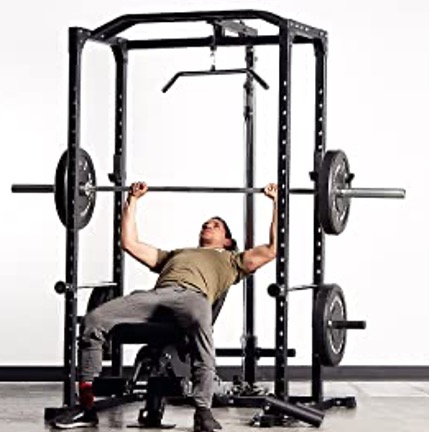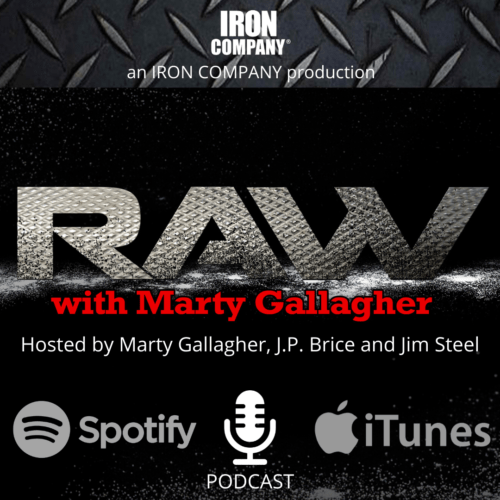
Power Rack Training
The Power Rack - More than just a spotter!
A tricked-out power rack: note overhead a two-pulley lat pulldown; BTW this guy’s safety catch pins are set way too low. If he missed the rep, he is pinned with the barbell on the front of his neck leaning backwards
For the serious strength athlete, next to the barbell, the power rack is the most important piece of strength equipment in any progressive resistance gym. Used right, the power rack creates a dozen different exercise possibilities. Most importantly, the power rack acts a spotter for two of the Core Four lifts, the squat and bench press. The power rack enables the lifter to perform a half dozen deadlift assistance exercises undoable otherwise. The power rack overhead crossbeam provides a perfect pull-up/chin bar. I have a simple extension on my power rack that houses a dual overhead pulley allowing me to do lat pulldowns and tricep pushdowns with all the different handles.
With a simple weight bench that inclines (and a power rack) I can safely do heavy, limit, full ROM sets in the seated incline press, front press, and braced press-behind-the-neck press. I can also perform partial reps in any pushing or pulling exercise. A friend of mine has a dip attachment on his power rack that I am highly envious of. We lean against one upright to make our bicep curls stricter: head and glutes stay in contact with the upright throughout the curl set, great with both barbell and dumbbells. Let the elbows rise-up at the and of each rep for extra bicep contraction.
I use the power rack as a “stretching enhancer.” I have devised a series of standing, hanging, and lying stretches for my hamstrings, quads, calves, pecs, shoulders, biceps, lats, and triceps. The combination of the rock-solid immobility of the power rack, and skillful body positioning enables me to stretch, say my hamstrings, with increasing amounts of my own bodyweight. I modulate the amount of pressure. I relax while at my current stretch limit. What a fabulous pec/shoulder stretch? Set a cross-pin at waist height. Back up to it, grasp the pin with both hands and sink down gradually allowing more of your bodyweight to increase the intensity of the stretch.
There is no better latissimus dorsi stretch than to use lifting straps to strap yourself to an overhead power rack cross member and just hang. Take the grip out of the stretch equation. A person can hang a lot longer and get a far better, deeper lat stretch with straps (and a high pain tolerance.) Effective stretching, like effective resistance training, is all about bumping up against the limits of capacity: resistance training capacity? Poundage, reps, technique selected; stretching capacity? Increasing current limits on range of motion. Flexibility is not improved by repeatedly doing what you are already capable of. Flexibility improves by stretching further and better (improved technique) than you ever have.
The power rack was designed to aid Olympic weightlifters. In the early 1960s there was much interest in pure isometrics as a potential strength breakthrough. To that end, the York Barbell company began marketing isometric devices. The original York power racks were outgrowths of the primitive York commercial isometric devices. The isometric rack never got commercial traction, but the York isometric push-pull device birthed the modern power rack.
The power rack used right allows the lone lifter, a man without spotters, to go as hard and heavy as if he had spotters. If he misses a rep, there is an exit strategy. For spotting in the squat and bench press, simply set the cross-member “pins” (the long bars) slightly below the turnaround point, the bottommost point in the squat and just below the level of the prone torso in the bench press. If you miss a squat rep, ride the barbell down to the pins and pop out from underneath. Miss a bench press rep? Ride the power bar down to the torso, exhale, high center the barbell, and squeeze out from underneath.
When the power rack first came into existence in the mid-1960s, the rack was used by Olympic lifters and powerlifters. Bodybuilders have always shied away from rack use. The low reps and short strokes used in power rack training seemed the anthesis of “attaining a maximal muscle pump,” the eternal credo of the bodybuilder. Powerlifters have made the longest continual use of the power rack, primarily for deadlift improvement, and muscling up the back muscles. The power rack is also the greatest of all grip enhancing tools. Here are the most common uses of the power rack….
- Partial repetition strategies: The original rack protocol was quite unusual and demanding. The major lifts were broken down into thirds. In the overhead press, the pins were set to allow the lifter to push upward from the shoulder to nose height. The lifter would perform three partial reps and hold the bar against the top pin on the 3rd rep: three partial reps followed by an isometric hold. Then, three reps and a hold in the mid-range. Finally, three reps and a hold eight inches from lockout. This strategy was used on every lift.
- Isometrics: This combination of partial reps ending in an isometric hold was (and remains) unique in all of resistance training. Wrestlers and football lineman found isometric of indeterminate length (lasting until the lifting can no longer hold the bar upward against the pin) to be the perfect strength training for the repeated clenches and tie-ups they experienced during a match or game. Isometric training is a lost art and the power rack is the ultimate isometric training tool.
- Partial rep deviations and rack deadlifts: Breaking the smaller lifts (bench presses, overhead presses) into thirds eventually proved problematic. Most rack users reduced from breaking the lifts into thirds into breaking the lifts in half. If your sticking point in the bench press was 10-inches from lockout, that is where you would set the pins. Rack lockouts have been used with great success for decades. To improve the deadlift lockout set the pins right above the knees. Lightly touch the bar to the pins at the bottom of each rep: triples are the preferred rep range. Wherever your sticking point is, regardless the lift, set the pins slightly below, and give extra work to the identified zone of weakness.
- Milo-style rack work: Don Reinhout is a superheavyweight powerlifting legend. He hailed from Minnesota. He stood 6-3 weighing 360. He used the “Milo and the calf” approach to build a massive deadlift. Whereas Milo lugged an ever-growing animal around the barnyard, Don would start his world championship deadlift preparation pulling what he wanted to deadlift in competition (875-pounds) for a mere 6-inches. This in week one. Each successive week for 14 weeks, Don would lower the pins three inches and repeat. At the end of his 12-week cycle, he pulled 875-pounds 2-inches off the floor. He deadlifted 887 in competition for an IPF world record two weeks later.
- Hugh Cassidy finds out who is leaking energy: Want to see if you have any “energy leaks” while squatting? Stand erect with a limit poundage, 300, 400, 500-pound + pounds, place a heavy loaded barbell on your back. Take it out of the squat racks as if you are going to squat it. Now stand three, erect, locked out, until it buckles your knees. The pins are set six inches below squat lockout. Any structural energy leak in the squat involves unlocked knees, hips, or both. The goal is to create a bone-on-bone lock. When this is accomplished, knees locked, pelvis rotated under, flexed glutes, the athlete can “stand all day,” as Cassidy noted. The man with the unlocked knees and bowed tailbone will begin to shimmy and shake like a palm tree in a hurricane within 10-seconds.
- “Get used to the weight”: Walter Thomas used the power rack similarly. If the multi-time world champion wanted to squat 720 in the up coming competition, at the end of every squat session during the 12-weeks leading up to the competition, Walter would break 720 out of the racks, step back, set up as if to squat – and just stand there. His pins were set six inches below. Each successive week he sought to stand longer and each successive week that 720 felt lighter and lighter.
- Grip work: As Iron Guru Hugh Cassidy once pointed out, the best assistance exercise for any lift is assistance exercises that most closely resembles the lift. Ergo, the best way to improve gripping a barbell is grip work where you use a barbell. Getting good at squeezing hand-grippers does nothing for hanging onto a limit deadlift. The best grip strengthener ever invented is short-distance lockouts in the power rack. The most favored rack grip exercise is to set the catch pins three inches below deadlift lockout. Using a double overhead grip, the lifter stands erect and simply holds the barbell for as long as possible. Hold until the bar opens the hands, breaks out of the lifter’s grasp, and falls onto the pins. Fight like hell as the weight pries open your fingers. Grip work is done at the end of the training session or on off days.
About the Author
As an athlete Marty Gallagher is a national and world champion in Olympic lifting and powerlifting. He was a world champion team coach in 1991 and coached Black's Gym to five national team titles. He's also coached some of the strongest men on the planet including Kirk Karwoski when he completed his world record 1,003 lb. squat. Today he teaches the US Secret Service and Tier 1 Spec Ops on how to maximize their strength in minimal time. As a writer since 1978 he’s written for Powerlifting USA, Milo, Flex Magazine, Muscle & Fitness, Prime Fitness, Washington Post, Dragon Door and now IRON COMPANY. He’s also the author of multiple books including Purposeful Primitive, Strong Medicine, Ed Coan’s book “Coan, The Man, the Myth, the Method" and numerous others. Read the Marty Gallagher biography here.



